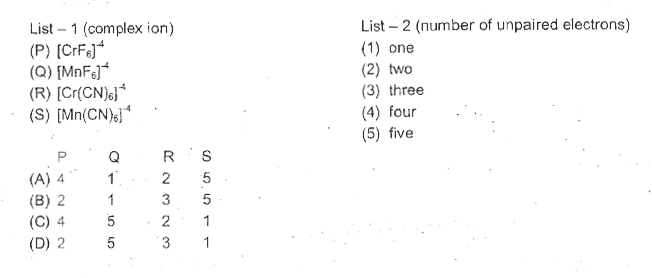(i) Calculate the change in entropy for the fusion of 1 mole of ice. The melting point of ice is 273 K and molar enthalpy of fusion for ice = 6.0 kJ/mole.
(ii) Calculate the standard of entropy change for the following reaction.
H+(aq)+OH(aq)→H2O(l)S∘(298K)/JK−1mol−10−10.7+70
(i) 21.8 J/K mole.
(ii) 80.7JK−1mol−1.
Topper's Solved these Questions
- THERMODYNAMICS AND THERMOCHEMISTRY Book:FIITJEEChapter:THERMODYNAMICS AND THERMOCHEMISTRY Exercise:EXERCISE 6
Explore 1 Video
- THERMODYNAMICS AND THERMOCHEMISTRY Book:FIITJEEChapter:THERMODYNAMICS AND THERMOCHEMISTRY Exercise:EXERCISE 7
Explore 1 Video
- THERMODYNAMICS AND THERMOCHEMISTRY Book:FIITJEEChapter:THERMODYNAMICS AND THERMOCHEMISTRY Exercise:EXERCISE 4
Explore 1 Video
- TEST PAPERSBook:FIITJEEChapter:TEST PAPERSExercise:CHEMISTRY
Explore 747 Videos
- TRANSITION ELEMENTS & COORDINATION COMPOUNDSBook:FIITJEEChapter:TRANSITION ELEMENTS & COORDINATION COMPOUNDSExercise:MATCHIG LIST TYPE QUESTIONS
Explore 1 Video
Similar Questions
(i) Estimate the average S.F bond energy in SF6. The standard heat of formation values of SF6(g),S(g) and F(g) are −1100,275 and 80 kJ mol−1 respectively.
(ii) The heat liberated on complete combustion of 7.8 g benzene is 327 kJ. This heat has been measured at constant volume and at 27∘ C. Calculate heat of combustion of benzene at constant pressure at 27∘ C, (R=8.3Jmol−1K−1)
View SolutionDetermine Ai and Ac for the reversible isothermal evaporation of 90.0 g of water at 100∘ C. Assume that water vapours behaves as an ideal gas and heat of evaporation of water is 540calg−1(R=2calmol−1K−1)
View Solution(i) A sample of a gas initially at 27∘ C is compressed from 40 litres to 4 litres adiabatically and reversibly. Calculate the final temperature (Cv=5) cal/mole.
(ii) Calculate the maximum work done in expanding 16 gm of oxygen at 300 K and occupying, a volume of 5dm3 isothermally until the volume becomes 25dm3.
(iii) 10 gm of argon gas is compressed isothermally and reversibly at a temperature of 27∘ C from 10 litre to 5 litre. Calculate q, w.ΔE and ΔH for this process. (R = 2.6 kcal/K).
View SolutionFor a 3s-orbital
Φ(3s)=1a√3(1a0)3/2(6−6σ+σ2)∈−σ/2
where σ=2rZ3aσ
What is the maximum radial distance of node from nucleus?
View Solution
View SolutionCalculate the change in entropy for the fusion of 1mol of ice. The melting point of ice is 300K and molar enthalpy of fustion for ice =6.0kJmol−1.
View SolutionAt 0^(2)C , if enthalpy of fusion of ice is 1365 kcal/mol. The molar entropy, change for melting of ice at 0^(@)C is
View SolutionEnthalpy of fusion of water is 6.01 kJ mol−1. The entropy change of 1 mole of ice at its melting point will be:
View SolutionCalculate the change in entropy for the fusion of 1 mole of ice (water). The melting point of water is 273 K and molar enthalpy of funsion for water =6.0 kJ mol^(-1)
View SolutionOne mole of ice is converted into water at 273 K. The entropies of H_(2)O(s) and H_(2)O(l) are 38.20 and 60.01 J mol^(-1)K^(-1) respectively. Calculate the enthalpy change for this conversion a ?
View SolutionThe change is entropy for the fusion of 1 mole of ice is [M.P of ice = 273 K molar, enthalpy of fusion for ice = 60 kJ mol^(-1) ]
View SolutionCalculate the entropy change during the melting of one mole of ice into water at 0∘C and 1 atm pressure. Enthalpy of fusion of ice is 6008J mol−1 .
View SolutionIF the melting point of ice is 273 K and molar enthalpy of usion for ice = 6.0 kJ mol^(-1) , the change in entropy for the fusion of 1 mole of ice will be
View SolutionCalculate the change in entropy for the fusion of 1 mol of ice. The melting point of ice is 273 K and molar enthalpy of fusion of ice = 6KJmol^(-1)
View SolutionFor the melting of ice at 25∘C:
H2O(s)→H2O(l)
The enthalpy of fusion is 6.97kJmol−1 and entropy of fusion is 25.4Jmol−1K−1.Calculate the free energy change and predict whether melting of ice is spontaneous or not at this temperature.
View Solutionएक मोल बर्फ के गलन करने पर होने वाले एण्ट्रॉपी परिवर्तन का मान होगा [बर्फ का गलनांक = 273 K, बर्फ के लिये गलन की मोलर एन्थैल्पी = 60 kJ mol−1 है
View Solution

